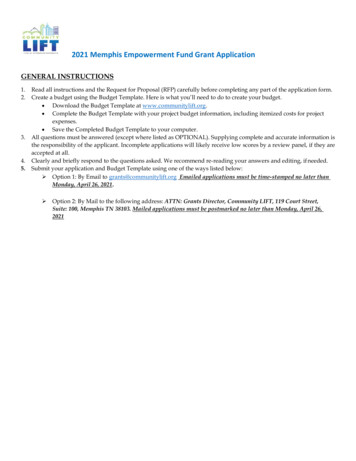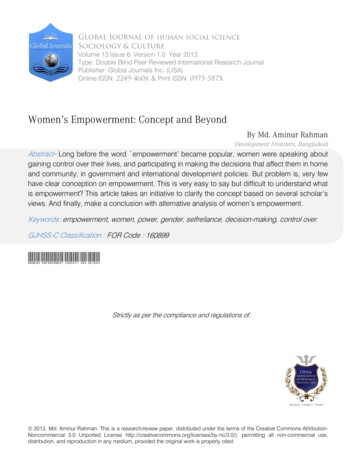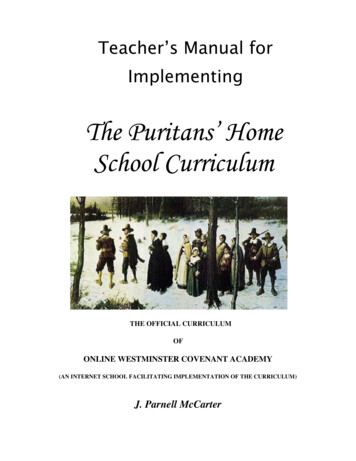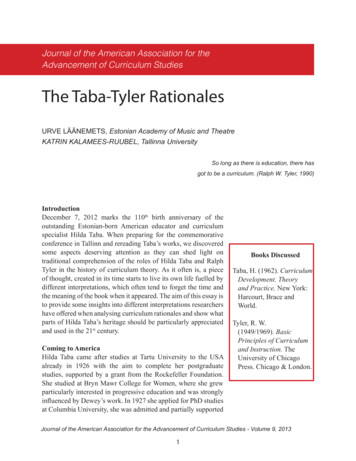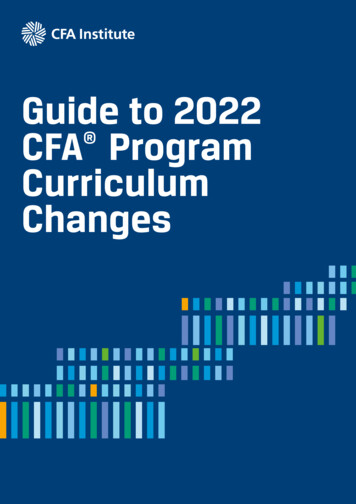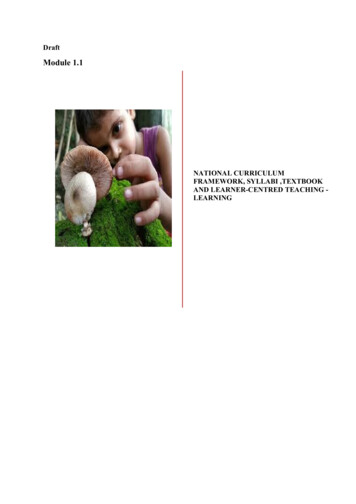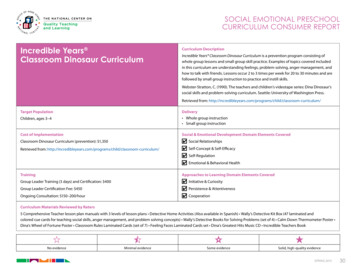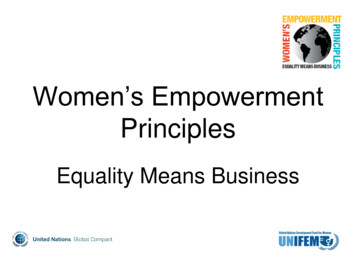
Transcription
EMPOWEREDUEMPOWERA INSPIREATEINSPIRELEAMENTORCHANGEINFORMSUPPORTVAV LUERESPEVATCOMMUNICATAATGIRLS’ RIGHTSAN EMPOWERMENTCURRICULUM
The Population Council confronts critical health and developmentissues—from stopping the spread of HIV to improving reproductivehealth and ensuring that young people lead full and productive lives.Through biomedical, social science, and public health research in 50countries, we work with our partners to deliver solutions that lead tomore effective policies, programs, and technologies that improve livesaround the world. Established in 1952 and headquartered in New York,the Council is a nongovernmental, nonprofit organization governed byan international board of trustees.Population CouncilOne Dag Hammarskjold PlazaNew York, NY 10017Tel: 212-339-0500Fax: 212-775-6052www.popcouncil.orgEmail: publications@popcouncil.orgEmail: info.zambia@popcouncil.orgPopulation Council – ZambiaPlot 3670 No. 4 Mwaleshi RoadOlympia ParkP/Bag RW 319XLusaka, Zambia 10101Tel: 260 211 295925This curriculum has been adapted from several sources which are listed inthe References section and footnoted throughout.This curriculum was funded by a grant from the United States Departmentof State as part of the DREAMS Innovation Challenge, managed byJSI Research & Training Institute, Inc. (JSI). The opinions, findings, andconclusions stated here are those of the authors and do not necessarilyreflect those of the United States Department of State or JSI.Suggested citation: Jackson Hachonda, Natalie, Nicole Haberland,Barbara Mensch, Pamela Nyirenda, Diana Bulanda-Shalala (eds.). 2018.GirlsRead! Girls’ Rights: An Empowerment Curriculum. New York:Population Council. 2018 The Population Council, Inc.Any part of this volume may be photocopied without permission fromthe authors or publisher, provided that publication credit is given andcopies are distributed free. Any commercial reproduction requires priorwritten permission from the Population Council. Please also credit anyoriginal sources as noted for selected activities. For inquiries regardingrights and permission, including translations, please contactpublications@popcouncil.org.ISBN: 0-87834-139-02
acknowledgmentsThis curriculum was developed for the GirlsRead! project. We aregrateful to the Forum for African Women Educationalists in Zambia(FAWEZA), the key implementing partner for GirlsRead!, for providingtechnical input on the selection of topics and materials for adaptationof this manual.We would like to acknowledge several organizations whose materialshave been adapted or used in this curriculum including: Centrefor Development and Population Activities (CEDPA), ECOS, GlobalChildren’s Fund, Innovations for Poverty Action (IPA), International HIVand AIDS Alliance, International Sexuality and HIV Curriculum WorkingGroup, Instituto PAPAI, Johns Hopkins Bloomberg School of PublicHealth/Center for Communication Programs, Native Youth SexualHealth Network, PACER’s National Bullying Prevention Center, PeaceCorps, Population Council, Promundo, Raising Voices, Salud y Género,Sonke Gender Justice, and World Education.Citations for the materials used from these organizations can be foundin the footnotes of the respective sessions, and a consolidated list ofreferences, including links to websites, is located in the Referencessection at the end of this document.We would like to thank the United States Department of State as thefunder and JSI Research & Training Institute, Inc. (JSI) as the grantmanager for the grant under the DREAMS Innovation Challenge thathas made GirlsRead! possible.3
table of contentsAcknowledgments . 3Session 7Communication skills . 60Session 18Negotiation and leadership . 168Session 8Decision-making . 71Session 19Making the world a better place . 178Session 9Bullying, fairness, and empathy . 79Appendix . 185Overview of GirlsRead! . 5Beneficiaries . 5Before the program begins . 6General facilitation tips . 7Talking about sensitive issues . 9Session 10Puberty and the body . 89Glossary . 186Fact Sheets . 191Working with parents . 10Session 11Sexuality . 97References . 217Session structure . 10Session 12Intimate relationships . 105Session 1Introducing GirlsRead! . 12Session 2Goal setting . 21Session 3Gender norms and attitudes . 29Session 13Sexual harassment,sexual coercion, and rape . 113Session 14Pregnancy and contraception . 124Session 4Valuing oneself . 38Session 15Partner violence and power inrelationships . 135Session 5Rights and responsibilities . 46Session 16HIV, STIs, and their prevention . 145Session 6Gender in society . 54Session 17Financial education . 1574
introductionOverview of GirlsRead!Zambian adolescent girls are at risk for premature school leaving andHIV infection due to a host of contextual factors including early childmarriage, early childbearing, harmful gender norms, and intimatepartner violence.The overall goal of GirlsRead! is to enhance learning and increaseprogression to secondary school among Zambian adolescent girlsin grade 7, the last year of primary school. It works in three districts:Lusaka, Ndola, and Chingola which have been targeted by theDetermined Resilient Empowered AIDS-free Mentored Safe (DREAMS)Core intervention funded by the US President’s Emergency Plan forAIDS Relief (PEPFAR) to prevent HIV in adolescent girls and youngwomen ages 10-24 in 10 countries in sub-Saharan Africa. GirlsRead!is part of the DREAMS Innovation Challenge, a US State Departmentfunded initiative working in conjunction with DREAMS Core to testinnovative initiatives in six challenge focal areas. GirlsRead! is part ofthe “Keeping Girls in Secondary School” focal area.Through GirlsRead!, Population Council, together with FAWEZA andWorldreader are aiming to improve school retention by bolstering girls’learning outcomes, furthering social connections, improving criticalthinking skills, increasing agency, and fostering community normssupportive of girls’ schooling. GirlsRead! participants meet in groupsof 15-20 girls in weekly group meetings called safe spaces under theguidance of a female mentor to directly engage girls in critical thinkingabout gender inequalities and discrimination, and help girls buildthe assets and confidence needed to act on their own behalf and asprogressive voices in their communities.The safe spaces are broken up into two parts with two differentcurricula. During the first part of the safe space, mentors use thiscurriculum, GirlsRead! Girls’ Rights: An Empowerment Curriculum, tofacilitate sessions that aim to:1. Increase adolescent girls’ understanding of gender equality, rights,sexual and reproductive health, and HIV.2. Reinforce and promote attitudes and behaviors that will lead to abetter quality of life for adolescent girls, including reducing bullying,harassment, and sexual coercion.3. Instill skills among adolescents to enable them to overcomethe challenges of growing up and becoming responsible adultsincluding communication skills, decision-making and negotiation,goal setting and developing healthy relationships.During the second part of the safe space, mentors use the curriculum,GirlsRead! E-reader Curriculum, to facilitate sessions that aim to:1. Introduce the basic steps of how to use an e-reader and access theapproximately 100 e-books loaded onto the e-reader.2. Build participants’ reading skills.3. Foster participants’ joy of reading.BeneficiariesGirlsRead! participants are girls in grade 7—the last year of primaryschool—when they are at high risk of leaving school.Group structureEach group meets once a week in the afternoon after their morningclasses. The sessions will last 2 hours, with the first hour focused onthe empowerment curriculum and the second hour focused on thee-reader curriculum.Meeting functionsThe meetings serve two functions. The first is for the mentor tofacilitate a short training session. There are 19 sessions that covera range of topics from gender equality to sexuality to rights. Thesesessions should be engaging, interactive, and learner-centered.Continued on next page5
introduction (cont.)The second function is for the meetings to provide a space andopportunity for girls to regularly interact with each other. Duringmeeting times, they can share updates about their weeks, address anyconcerns they may have, laugh, sing, dance, express themselves, andin general, have fun. As cultivating this sort of environment is a primaryaim of weekly girls’ group meetings, it is important that these groupsnot be run like a classroom. Mentors will have to ensure that duringeach meeting, girls have ample time for conversation and interaction,and should encourage an informal learning environment.Before the program begins*Mentors should peruse the curriculum and thoroughly read as muchof the background information as possible (i.e. facilitator notes at thebeginning of each session and extra information provided in the FactSheets in the Appendix at the end of the document). This will helpmentors gain a strong general sense of the topics that will be coveredthroughout the program, and an idea of where to find answers to anyquestions that participants may ask. This information for each sessionshould be re-read just before conducting the corresponding session.Mentors should prepare any necessary materials before each sessionahead of time, as well as think about their own values regarding youngpeople, and the topics to be discussed.Know your audienceDepending on the group, it may be necessary to change the approachto leading the sessions. For example, some groups may have lowerliteracy skills than others. For lower literacy groups, facilitators maywant to draw more pictures and use more symbols when writing onthe chalkboard. Facilitators should also use simple language and besure that the instructions are clear before starting any activity.It is important that mentors work with participants according to theireducation/competency level. Mentors should also check sessions forcultural acceptability. Be familiar with local cultural norms and adjustsessions accordingly.Be preparedEvery training experience has the potential to raise challenges. Themost effective way to minimize challenges is to be prepared. Mentorsshould know the material they will present and practice facilitating theactivities on their own or with a friend.Continued on next pageCollect and have referral information on hand for:1. Sexual/reproductive health services (including contraceptives)2. HIV testing and counseling3. How/where to report sexual or domestic violence4. Psychosocial counseling referral for any girls who have beenabused or raped5. Legal services*Sources: International Sexuality and HIV Curriculum Working Group. 2009, updated 2011. It’s All One Curriculum: Guidelines and Activities for a Unified Approachto Sexuality, Gender, HIV and Human Rights Education. New York: Population Council. Activities: Pages 2-7; Population Council. 2013. Life Skills and HealthCurriculum for the Adolescent Girls Empowerment Program (AGEP). Pages 1-9.6
introduction (cont.)General Facilitation TipsBelow are some tips and methods to help build your capacity as afacilitator.Establish a learning environment based on equality, respect, andhuman rights.1. Create a supportive learning environment. All participants shouldfeel involved, listened to, comfortable, and safe from ridicule,especially when they take risks with new ideas. Encourageparticipation, particularly among those who feel alone orintimidated. (Various conditions and situations can trigger suchfeelings. For example, differences in social power associatedwith gender, social class, or age can be a factor. Participants withlimited fluency in the language spoken at school may avoid joiningdiscussions. Those living with a physical disability or other specialneeds may feel shy.) You can boost class involvement by usingactivities that promote respect and team building and by spreadingleadership opportunities. Of course, it is also important to ensurethe safety and privacy of the physical space.2. During an early session, ask participants to work together to devisea list of guidelines for their own respectful classroom.3. Ask participants to respect other people’s privacy, and remindthem not to disclose information to others that they feel shouldbe kept private. Consider how some participants might intimidateor even abuse others after leaving a classroom in which sensitivetopics have been discussed. Assure them that you, as their mentor,will keep all discussions confidential. In this way, you serve as arole model for respecting others’ privacy.4. Make certain that they understand that they have the right not toparticipate or share if doing so makes them uncomfortable.5. Encourage all participants to share their thoughts. Do not judgetheir ideas.Foster a process that draws on participants’ experiences, integratingnew information and ideas into what they already know and thinkabout a topic.1. Remember that all participants have knowledge and experience.Listen and ask questions to draw them out.2. Listen to their concerns and pose hypothetical problems thatreflect their real lives. Engage them in solving these problems,making their own choices and developing their ideas along theway.3. Encourage them to explore the significance of an issue in theirown lives.4. Think of your role as facilitating discussion of participants’ ideasrather than as a lecturer or transmitter of information. Sometimesyou may need to correct factual errors or help them recognizewhen a comment is disrespectful.5. Occasionally, you may wish to share an example from your ownexperience that is relevant to the lesson. However, be extremelycareful to maintain appropriate boundaries with the participants.Build on their power to reflect, study, and think critically about theirown lives and the world around them, and to solve problems.1. Encourage participants to question conventional wisdom. Askthem to think about their beliefs and their community’s standardsand norms. Invite them to explore opinions different from theirown in a respectful manner.2. Encourage creativity.3. Encourage them to take risks in their thinking and to be unafraid ofmaking mistakes. Be willing to demonstrate such behavior yourself.4. Organize small groups to explore issues and engage in collectiveactivities.5. Encourage various perspectives in analyzing problems andsuggesting possible solutions.Continued on next page7
introduction (cont.)Foster participants’ ability to apply what they learn to their lives andcommunities, that is, help them to become active citizens and forcesfor positive change.1. Repeatedly ask participants to relate the content to their own livesand world. Encourage them to consider the material in light ofprinciples of fairness and social justice.2. Be aware of the environment in which you work so that you canavoid putting participants in harm’s way.3. Keep in mind that young people often draw inspiration from theirteachers and community leaders.A good facilitator1. Sees the participants as experts with information and skills toshare, rather than seeing themselves as the only experts in theroom.2. Encourages participants to learn from each other, and guides thisprocess rather than providing direct instructions and lecture-stylelearning.3. Believes we learn by doing, experiencing, practicing, and feeling,rather than by memorizing, repeating, and recording information.4. Is organized, but flexible in changing methods based on participantneeds.5. Is enthusiastic about the topic and participants.6. Keeps promises to the group – to let participants speak, take abreak, etc.7. Is patient and a good listener.8. Is prepared to handle strong emotions that may arise duringdiscussions.Before each session1. Carefully read through all of the session’s background notes andactivities. Think about how you will perform each step and whatyou will add to every session.2. Try to anticipate questions that may be asked, and know whereto look for answers in the materials provided. If participants askquestions that you cannot answer right away, write them down andfollow-up on them before the next session, so that you can discuss3.4.5.6.them then.Adapt the activities and group discussions to make them moreappropriate to the age and education level of your participants.Think about and plan for any issues that may arise during more“difficult” sessions with complex material or sensitive topics.Think of local examples and ways to make the activities morerelevant to the participants’ daily lives and concerns.Have materials prepared beforehand.Additional facilitation tips1. Have a “parking lot” for issues that arise during a session, but thatare not relevant to the session objectives. You can come back tothem at another time or simply explain at the end of the trainingthat it was important, but outside of the scope of the curriculum.2. Capture important points on the chalkboard during discussionsfor use during the summary activities. It can be very challenging toboth lead the discussion and write down all important points, soconsider having someone assist you in writing down key points.3. Whenever appropriate, identify next steps or possible solutions toproblems.4. Relate the information to what has been learned in previoussessions whenever possible.5. Check to make sure you are not speaking more than theparticipants. If you find that you are doing most of the talking,encourage participants to answer each other’s questions. Forinstance, if someone asks a question, open discussion to theparticipants with the inquiry: “Does anyone have an answer to thatquestion?”6. The way you hold your body will help effectively facilitate thegroup. Being attentive and nodding will make them feel theircontribution is important. Looking away can effectively tell theperson not to talk or participate. Always face the person to whomyou are speaking.7. Have fun!Continued on next page8
introduction (cont.)Talking About Sensitive IssuesMany of the issues raised in this manual are linked to sex, relationships,violence, and HIV, which are often seen as sensitive topics to bothparticipants and facilitators. Some facilitators may feel that talkingabout sex and contraception with young people encourages youngpeople to have sex. On the contrary, research shows that sexuality andHIV education does not lead to earlier sexual initiation nor does it leadto riskier sex. However, facilitators should not assume the participantsare abstaining from sex.Young people will often giggle with embarrassment when discussingtopics related to sex or reproduction. Mentors should not let thisdiscourage them or make them uncomfortable. Girls need accurateinformation on these subjects to make healthy choices and feelmore comfortable with the changes they are experiencing. Let theembarrassment pass, wait for girls to settle down, and then focus onthe information and skills they need. You might consider having all thegirls say “vagina” or “penis” together to help them get their giggles out.Tips for mentors to let participants know you are comfortable talkingabout these issues1. Think about your own values and clarify how you feel about anissue before you discuss it with participants.2. Be prepared and plan ahead. Find out as much as you canbeforehand, so that you feel confident facilitating the session.3. You do not have to know everything. Be honest with participantswhen you are not sure how to answer their questions. Turn thequestion into an investigative project and ask participants to helpyou find the answer. Tell them that you will also ask a health careprovider or another expert and try to have answers for them at thenext session.4. Accept participants’ slang terms. Don’t be afraid to ask what theymean if you don’t know.5. Do not dismiss or look down on what participants know.6.7.8.9.Participants have been exposed to a variety of information andexperiences. Their experiences have value and are important.Set your own limits. Participants will be excited because you areprepared to talk about topics that interest them. Few adults guide themor give them this knowledge, so they may ask questions that makeyou feel embarrassed. Be as open and honest as you can, but tell themwhen it is enough or when their behavior is disrespectful. Explain whenyou feel uncomfortable answering a particular question.Do not answer personal questions about your own sexualexperience. If these questions come up, let participants know thatyour role as a facilitator is not to discuss your own experience.Stick to the facts. You might have personal opinions about thetopic, or how you personally would act in a certain situation, but itis important to remain neutral and open so that the participants willfeel free to ask any question and share their thoughts, fears, andopinions.Get advice and help if you need it. Teaching life skills andreproductive health is not easy. If you had a difficult session, findsomeone you trust to talk with afterwards. However, respect theparticipants’ privacy and do not share personal information thatthey shared with you during the session, unless you feel they maybe in danger. Information from participants may be shared inmeetings between mentors, as long as the identity of the participantinvolved is not disclosed.Handling emotionParticipants may get emotional during group meetings. Mentors shouldreact sensitively and effectively when a participant becomes visiblyupset during a session. Mentors should strive to ensure that participantsfeel safe and are not embarrassed so that the group can move past anyawkwardness or discomfort. Ways for a mentor to deal with an emotionalsituation include: moving the discussion away from an upsetting topic,relating an anecdote, moving on to a new topic, or taking a break.Continued on next page9
introduction (cont.)Participants may also get upset by some of the topics in the groupmeetings. They may have doubts about themselves or may feeluncomfortable talking about issues related to sex with other adolescents.The discussion activities may remind them of their own uncomfortablesituations, or their own experience of abuse, at home or at school.If a participant is upset by an activity, the mentor should try to talk to theparticipant privately in order to find out how and why the participant isuncomfortable. The mentor may suggest that the participant step out of themeeting space. The mentor should not force the participant to talk aboutwhat is upsetting, but should be available to listen if the participant would liketo talk. Listen to what the participant says. A mentor’s role is to provide theparticipant with understanding, support, and assistance. The mentor shouldnot tell the participant how she feels or how the mentor thinks the participantshould feel; instead, assure the participant that it is normal to feel upset.Please note: As a mentor, you should be prepared to provide aparticipant who has been abused with contact information forpsychosocial counseling. The GirlsRead! project will provide you withthis information and you should have it on hand before the first session.Working with ParentsParents are co-educators in teaching life skills and reproduction totheir children. If teachers, community members, religious leaders,and parents can work together, then young people are more likely toemerge as well-rounded, healthy individuals. Unfortunately, it is notalways easy to collaborate with parents. Parents often have concernswhen reproduction is taught and they may not feel comfortable orequipped to deal with these issues themselves.Tips for working with parents1. Keep parents informed about what you are doing and why.2. Get the opinions of parents.3. Talk with parents about their concerns and fears aroundreproductive health and HIV and AIDS. Do this through GirlsRead!parent meetings and home visits.4. Invite parents to meetings to discuss their concerns.5. Know your community. Find out about its needs and concerns, aswell as the skills and expertise of the parents. For example, a parentmay be a nurse at a local clinic who could talk to the participantsand give you advice and support.6. Involve parents. Assign activities that require participants to talk totheir parents. For example, ask participants to interview their parentsor family members about when they were young.Session StructureThe GirlsRead! Girls’ Rights: An Empowerment Curriculum has 19sessions. Each session is outlined as follows:-- Session description-- Objectives-- Session time-- Required materials-- Pre-session preparation-- Facilitator notes & terms-- Warm-up & action item debrief-- Activities-- Wrap-up-- Action itemSession titleThe session title names the main topic covered in the session.Session descriptionThe session description summarizes the activities undertaken in eachsession.Continued on next page10
introduction (cont.)ObjectivesThe objectives provide an overview of the learning aims and purpose ofeach session.Session timeA breakdown of the estimated time to be spent on each activity isprovided at the beginning of each session and underneath eachactivity title. These general time frames have been assigned to aid indetermining the division of time between each activity in a session sothat all the material can be covered. However, participants may wantto explore some issues in more depth, or at other times they may workthrough the material more quickly. Allow participants flexibility withthe space and time allocated to each part of a session. This will helpthem grasp key messages associated with each session and develop anunderstanding of how to apply the information to their lives.Required materialsMaterials needed to prepare for each session are listed. Participantswill be provided with notebooks to use for note-taking and working onvarious activities throughout the program. They should be remindedto bring these with them to each session. Chalk and a chalkboard areneeded for most sessions. When these materials are not available,adapt the session accordingly.Pre-session preparationPreparation activities for each session are noted. It is important for thefacilitator to complete these preparations before each session. Beingprepared for the learning session will make the facilitator’s job much easierand help the session to run smoothly. Review this information carefully.Facilitator notesThese notes provide details about relevant session backgroundinformation for the facilitator, additional session-specific tips that maybe helpful, and reminders about how to facilitate each session.TermsTerms relevant to each session are listed and defined. These definitionscan be referred to throughout the session as terms are discussed or ifclarification of terms is needed. A consolidated list of all terms in thecurriculum is located in the Glossary of Terms.Warm-up/action item debriefA warm-up and action item debrief are included at the beginning of asession. Ideally the warm-up is related to the session topic. The actionitem debrief is a time to discuss the results of the action item assignedat the end of the previous session.ActivitiesStep-by-step instructions for the learning activities are provided toguide the facilitator in helping participants learn and work with theconcepts of the session. The steps are listed in the order in which theyshould be implemented and it is intended that the steps be followed asoutlined. While a general script for each session is provided, facilitatorsshould feel free to use their own words to explain each point.Wrap-upA suggested outline to wrap-up each session normally includesinstructions to ask participants to summarize what they have learnedduring the session while the facilitator fills in any key points they miss,addresses any questions or comments, and ends the session on apositive note, with a clear key message.Action itemAction items are to help reinforce the skills and knowledge that weregained during the session. Participants work on these simple, shortassignments between sessions, and their experience undertaking themare discussed at the beginning of the following session.11
EmpowerEducateInspireLeadmenTorLeadchanSession 1geInformSuppoIntroducing GirlsRead!rtValueRespectCommunicateleadEmpowerEdu
session 1 / introducing girlsread!Session DescriptionAn introduction to the program and explanation of the purpose ofGirlsRead! safe spaces.ObjectivesBy the end of the session, participants will:-- Know each other better-- Develop confidence in representing themselves in front of others-- Understand the program goals-- Establish ground rules for safe space meetings-- Think about education benefits, barriers, and solutionsSession Time1 hourWarm-up: Knowing each other, 10 minutesActivity 1: Introducing GirlsRead! safe spaces and gr
Girls’ Rights: An Empowerment Curriculum, to facilitate sessions that aim to: 1. Increase adolescent girls’ understanding of gender equality, rights, sexual and reproductive health, and HIV. 2. Reinforce and promote attitudes and behaviors that will lead to a better quality of life for adoles
